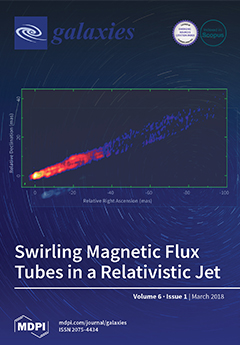It is theoretically expected that active galactic nucleus (AGN) jets should carry helical magnetic (
B) fields, which arise due to the rotation of the central black hole and accretion disk combined with the jet outflow. The direction of the toroidal component
[...] Read more.
It is theoretically expected that active galactic nucleus (AGN) jets should carry helical magnetic (
B) fields, which arise due to the rotation of the central black hole and accretion disk combined with the jet outflow. The direction of the toroidal component of the helical
B field
is determined by the direction of the poloidal component
of the initial seed field that is “wound up” and the direction of rotation of the central black hole and accretion disk. The presence of the jet’s helical
B field can be manifest both through the presence of Faraday rotation gradients across the jet, and the presence of appreciable circular polarization, which comes about when linearly polarized emission from the far side of the jet is partially converted to circularly polarized emission as it passes through the magnetized plasma at the front side of the jet on its way towards the observer. When both of these properties are manifest, they can be used jointly with the jet linear polarization structure to uniquely determine both the direction of
and the direction of the central rotation. This technique has been applied to 12 AGNs. The results indicate statistically equal numbers of outward and inward
and of clockwise (CW) and counter-clockwise (CCW) rotations of the central black holes on the sky. However, they suggest that the directions of
and of the central rotation are coupled: CW/CCW central rotation is preferentially associated with inward/outward poloidal
B field. This leads to a preferred orientation for the toroidal
B-field component corresponding to inward current along the jet.
Full article





